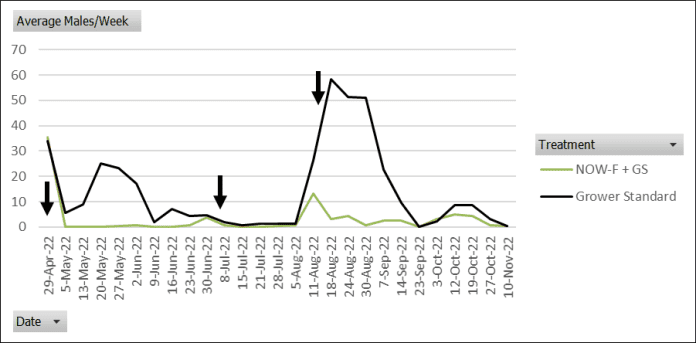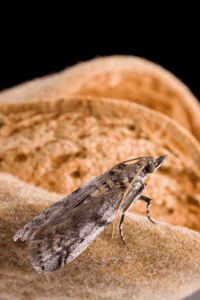
It is the consensus across California’s nut crop industries that mating disruption for navel orangeworm (NOW) is a foundational component of the integrated pest management program and adds significant value. Every article, conference and workshop in recent years validates the efficacy of this technology and encourages adoption.
Leading into the 2023 season, with many uncertainties on the horizon, growers were faced with the annual challenge of developing their management plans. Concerns over crop prices, input costs, and water availability contributed to the need for leaner budget approaches. In many cases, difficult decisions to reduce or eliminate mating disruption, along with activities such as sanitation and other important inputs, were deemed necessary.
In the months to follow, record rainfall hit the state, replenishing some much-needed water supply but also causing significant destruction to farmland across California.
Growers fortunate enough to have viable orchards this season now face the task of reevaluating the season’s harvest potential. Delivering the highest-quality crop is as important as ever to maximize quality bonuses, especially with potentially lower yields due to disease and less than optimal bee hours for pollination. Ensuring the highest payment possible may help offset these economic losses.
This means growers are looking for modest investments to increase quality by revisiting earlier budget decisions due to increased water availability and affordability, optimism regarding nut crop prices, and stabilization of other input costs like fertilizers.
Unfortunately, some valuable investments like sanitation and season-long aerosol mating disruption were not possible due to budgets and inaccessible fields. Despite the potential that a colder, wetter winter may have increased NOW overwintering mortality, the inability to achieve sanitation targets will result in higher mummy loads in many orchards. These mummies will serve as resources for the early generations of NOW that survived, building up substantial populations when this season’s crop becomes susceptible to infestation at hullsplit.
Also consider the relationship between crop set and percent NOW infestation. Each in-season nut that makes it to harvest represents a resource (potential “home”) for NOW to infest and be detected at the processor, contributing to the reject percent on the gradesheet. Lower crop set resulting in fewer overall nuts per acre means fewer “homes” for NOW and a higher likelihood of any individual nut becoming infested, potentially leading to losses in quality bonuses.
Nuts in lower-yielding years are also typically larger with a looser shell seal and are therefore more easily infested by navel orangeworm. As a result, higher percent infestation at harvest might be expected in lower-yielding seasons under similar NOW pressure if not mitigated.
Because one adult female NOW is capable of laying hundreds of eggs, populations can increase exponentially, reaching extremely high levels from hullsplit through harvest when it is most critical to protect this season’s crop. Each successful mating that is blocked or delayed significantly decreases the population growth rate to reduce harvest damage.
While it may be too late this season to adjust certain aspects of the NOW program such as sanitation, there is still opportunity to use a targeted approach to keep mating disruption pressure on NOW populations.
Many growers who were unable to commit to a season-long approach are now exploring other options to use mating disruption in their IPM programs, such as taking advantage of the flexibility and value that sprayable pheromones offer.
While season-long mating disruption of navel orangeworm remains the gold standard in nut crops, the versatility of sprayable pheromones provides the industry a more reactionary option when it comes to incorporating mating disruption into their programs. Similar to insecticide programs, sprayable pheromones allow growers and their crop advisers to make targeted in-season decisions, tailored to the specific needs of each individual block and operation.
The Science of Sprayable Pheromones
Sprayable pheromones are not a new technology. The first sprayable pheromone was registered in 1989 for the cotton pest, pink bollworm. Since that time, sprayable mating disruption products have been developed for a wide range of pests across the globe, including several key pests of specialty crops in California. Checkmate® NOW-F (referred to hereafter as NOW-F) sprayable pheromone was registered for navel orangeworm in California in 2019 and has seen continual increase in adoption by nut crop producers in the years since.
Classified as a capsule suspension (CS), this microencapsulated formulation has two primary components: the species-specific sex pheromone used to disrupt mating (the same active ingredient found in the aerosol) and the “matrix” that protects it from environmental factors while ensuring consistent release over time. Each microcapsule can be thought of as a microscopic dispenser, with each application akin to applying billions of micro-dispensers to the orchard.

The Sprayable Toolkit
Sprayable pheromones introduce the same mode of action as other mating disruption products but are more comparable to insecticides when it comes to decision-timing, use patterns, and application methods.
Other mating disruption delivery systems like season-long aerosols provide full season pheromone coverage for eight months or more depending on product selection. These options require decisions for use to be made early in the year, should be applied in March or April, and require an additional labor investment to deploy.
In contrast, traditional insecticides are viewed as a tool that can be incorporated when, where and how often needed and are not expected to have long residual activities covering the entire season. Sprayable pheromones combine the best of both worlds: a long-lasting sprayable NOW management tool with the unique mating disruption mode of action. NOW-F can be readily incorporated into existing spray programs as well as applied efficiently as a standalone spray, requiring less labor than other mating disruption approaches.
When considered as part of the sprayable toolkit, sprayable pheromones have characteristics that are both similar to and distinct from traditional insecticides. Like insecticides, decisions for NOW-F use can be made throughout the season as needed, usage patterns are tailored to each individual block, and it is applied using familiar spray methods. Differences between NOW-F and most traditional insecticides include coverage requirements, length of residual activity, pre-harvest intervals, re-entry intervals and maximum residue limits (MRLs).
CheckMate® NOW-F can be applied using ground or aerial equipment as stated on the label. Effective sprayable pheromone formulations do not require complete coverage because the active ingredient is released into the air from the microcapsules where it will then contact the male antenna to inhibit mate location. This characteristic allows stand-alone NOW-F sprays to be applied at lower volumes and faster speeds than traditional insecticides.
The key to effective applications of sprayable pheromone products is to achieve uniform distribution of microcapsules in the orchard through adequate coverage (lower volumes, faster speeds, every-other-row application, etc.). Growers have used typical air-blast applications, ultra-low volume methods, as well as various types of aerial applications including drones.
CheckMate® NOW-F sprayable pheromone has a four-hour re-entry interval, zero pre-harvest interval and is exempt from MRLs. Material cost at label rate is approximately $30/acre/application. NOW-F has a residual activity of up to 30 days, allowing for increased flexibility in application timing.
Part of an IPM Approach
To achieve the current industry standards for low NOW damage, in many situations a full IPM approach may be necessary. This includes mating disruption, sanitation, timely harvest and insecticide use as needed. Reduction of any components of the IPM program should be on an individual basis in consult among growers and their crop advisers.
As the manufacturer, we are often asked how to best use CheckMate® NOW-F in almonds and pistachios. Like insecticides, there is no single prescription, allowing the program to be tailored to each individual circumstance and operation based on pest management needs and desired outcomes.
In general, there are many approaches that can be considered when using sprayable mating disruption. These may include tank mixes (“free-ride”) with other applications, sprays precisely timed to pest phenology (male “flights”), applying on calendar basis, employing a season-long approach, or various combinations thereof. Like many insecticide programs, the number of NOW-F sprays and spray timings in a given season varies by block.
In California nut crop systems, most reported use patterns take advantage of the compatibility to tank mix NOW-F as a “free-ride” with other sprays and are applied based on the coverage, volume and speed requirements of the other materials in the tank. Standalone applications of NOW-F can be made quickly at precise times or when other insecticides cannot be applied due to pre-harvest or re-entry intervals.
Mating disruption is recognized as an important foundation of the IPM program for navel orangeworm. Effective mating disruption programs do not necessarily require full-season investment and early commitment, which are particularly challenging in years with uncertainty and budget limitations. Sprayable pheromones offer the most versatility as part of a long-lasting and effective option to use with other sprayable management tools, allowing growers to integrate all the benefits of mating disruption with the added flexibility of a targeted spray program.















